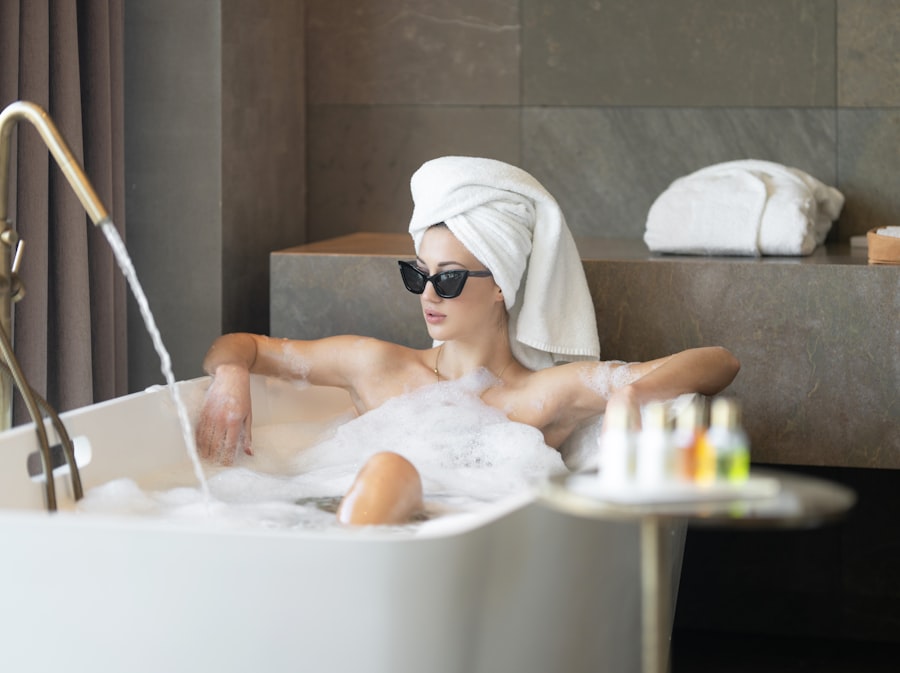Tension and stress are ubiquitous experiences in modern life, often manifesting as physical discomfort or emotional strain. Tension typically refers to the physical state of muscles being tight or contracted, which can occur in response to various stimuli, including anxiety, fatigue, or even environmental factors. Stress, on the other hand, encompasses a broader spectrum of emotional and psychological responses to perceived challenges or threats.
It can be acute, arising from specific events such as a job interview or a public speaking engagement, or chronic, resulting from ongoing pressures like financial difficulties or relationship issues. The interplay between tension and stress is complex; prolonged stress can lead to persistent muscle tension, creating a vicious cycle that exacerbates both conditions. The physiological response to stress is often referred to as the “fight or flight” response, a term coined by physiologist Walter Cannon in the early 20th century.
When faced with a stressor, the body releases hormones such as adrenaline and cortisol, which prepare it for immediate action. This response can be beneficial in short bursts, enhancing focus and energy levels. However, when stress becomes chronic, these hormones can lead to a range of health issues, including cardiovascular problems, digestive disorders, and weakened immune function.
Understanding the nuances of tension and stress is crucial for developing effective coping strategies, as it allows individuals to identify their triggers and implement appropriate relaxation techniques.
Key Takeaways
- Tension and stress can have physical and mental effects on the body, including muscle tightness and increased anxiety.
- Progressive Muscle Relaxation is a technique that involves tensing and then relaxing specific muscle groups to reduce tension and stress.
- The benefits of Progressive Muscle Relaxation include reduced muscle tension, decreased anxiety, improved sleep, and overall relaxation.
- To practice Progressive Muscle Relaxation, find a quiet and comfortable space, focus on each muscle group, and alternate between tensing and relaxing for a few seconds each.
- Incorporating Progressive Muscle Relaxation into your daily routine can be as simple as setting aside a few minutes each day to practice the technique, whether it’s before bed or during a work break.
What is Progressive Muscle Relaxation?
Progressive Muscle Relaxation (PMR) is a systematic technique designed to reduce muscle tension and promote overall relaxation. Developed by Dr. Edmund Jacobson in the early 20th century, PMR involves tensing and then relaxing specific muscle groups throughout the body.
The premise behind this method is that by consciously engaging and subsequently releasing tension in the muscles, individuals can cultivate a greater awareness of their physical state and learn to distinguish between tension and relaxation. This heightened awareness can be particularly beneficial for those who struggle with chronic stress or anxiety, as it provides a tangible way to manage their physical responses to emotional stimuli. The practice of PMR typically begins with the individual finding a comfortable position, either sitting or lying down.
The process involves focusing on one muscle group at a time—often starting with the feet and working upwards through the body. For instance, one might begin by tensing the muscles in the feet for several seconds before releasing them and noticing the sensation of relaxation that follows. This methodical approach not only helps to alleviate physical tension but also encourages mindfulness, as practitioners are prompted to pay attention to their bodies and the sensations they experience during the process.
Over time, regular practice of PMR can lead to improved emotional regulation and a greater sense of calm.
The Benefits of Progressive Muscle Relaxation

The benefits of Progressive Muscle Relaxation extend beyond mere muscle relaxation; they encompass a wide array of physical and psychological advantages. One of the most significant benefits is its ability to reduce anxiety levels. By engaging in PMR, individuals can lower their heart rate and blood pressure, creating a physiological state that counters the effects of stress.
Research has shown that regular practice can lead to decreased symptoms of anxiety disorders, making it an effective complementary treatment for those struggling with chronic anxiety. In addition to its impact on anxiety, PMR has been linked to improved sleep quality. Many individuals who experience high levels of stress find it difficult to unwind at night, leading to insomnia or disrupted sleep patterns.
By incorporating PMR into their bedtime routine, individuals can signal to their bodies that it is time to relax and prepare for sleep. Studies have indicated that those who practice PMR before bed report falling asleep more quickly and experiencing deeper sleep cycles. Furthermore, the technique can enhance overall well-being by fostering a greater sense of control over one’s body and mind, empowering individuals to manage their stress responses more effectively.
How to Practice Progressive Muscle Relaxation
| Step | Description |
|---|---|
| 1 | Find a quiet and comfortable place to sit or lie down |
| 2 | Start by tensing and relaxing each muscle group, starting from your toes and working your way up to your head |
| 3 | Hold the tension in each muscle group for 5-10 seconds, then release and relax for 20-30 seconds |
| 4 | Focus on your breathing and continue the process until you have tensed and relaxed all major muscle groups |
| 5 | Practice this technique regularly to reduce stress and promote relaxation |
Practicing Progressive Muscle Relaxation involves a series of steps that guide individuals through the process of tensing and relaxing their muscles. To begin, find a quiet space where you can sit or lie down comfortably without distractions. It is advisable to close your eyes and take several deep breaths to center yourself before starting the practice.
Begin with your feet; tense the muscles by curling your toes tightly for about five seconds while inhaling deeply. Focus on the sensation of tension building in your feet. After five seconds, exhale slowly while releasing the tension in your feet.
Pay close attention to how your feet feel as they relax; notice any differences between the tense state and the relaxed state. This awareness is crucial for developing a deeper understanding of your body’s responses. Gradually move up through your body—tensing and relaxing your calves, thighs, abdomen, arms, shoulders, neck, and face—spending about five seconds on each muscle group.
As you progress through each area, maintain your focus on your breath and allow yourself to fully experience the sensations associated with both tension and relaxation.
Tips for Incorporating Progressive Muscle Relaxation into Your Daily Routine
Incorporating Progressive Muscle Relaxation into your daily routine can be achieved with some thoughtful planning and consistency. One effective strategy is to set aside specific times each day dedicated solely to PMR practice. This could be in the morning as a way to start your day with clarity and calmness or in the evening as part of your wind-down routine before bed.
Establishing a regular schedule helps reinforce the habit and makes it easier to integrate into your lifestyle. Another tip is to create an environment conducive to relaxation. This might involve dimming the lights, playing soft music, or using aromatherapy with calming scents such as lavender or chamomile.
Reducing external distractions enhances your ability to focus on the practice itself. Additionally, consider pairing PMR with other activities you already engage in daily; for example, you could practice PMR during your lunch break at work or while waiting for an appointment. By associating PMR with existing routines, you increase the likelihood of maintaining consistency in your practice.
Progressive Muscle Relaxation can be particularly beneficial when tailored for specific situations that often induce stress or tension. For instance, practicing PMR before bed can significantly improve sleep quality by helping individuals transition from the busyness of daily life into a state of calmness conducive to rest. Engaging in PMR just before sleep allows you to release accumulated tension from the day while signaling to your body that it is time to unwind.
This practice can be especially helpful for those who find themselves ruminating over daily stresses as they try to fall asleep. During work breaks, PMR serves as an effective tool for combating workplace stressors that accumulate throughout the day. Taking just a few minutes during a break to engage in PMR can help clear your mind and restore focus.
For example, if you find yourself feeling overwhelmed by deadlines or meetings, stepping away from your desk for a brief PMR session can help alleviate physical tension in your shoulders and neck while also providing mental clarity. This practice not only enhances productivity but also fosters a healthier work environment by encouraging employees to prioritize their well-being.
Combining Progressive Muscle Relaxation with Other Stress-Relief Techniques
While Progressive Muscle Relaxation is an effective standalone technique for managing stress and tension, its benefits can be amplified when combined with other stress-relief methods. Mindfulness meditation is one such technique that complements PMR beautifully; both practices emphasize awareness of bodily sensations and promote relaxation. By integrating mindfulness meditation into your routine alongside PMR, you can deepen your understanding of how stress manifests in your body while cultivating a greater sense of presence in each moment.
Another effective combination involves pairing PMR with deep breathing exercises. Deep breathing techniques—such as diaphragmatic breathing—can enhance the relaxation response initiated by PMR by further lowering heart rate and promoting oxygen flow throughout the body. For instance, after completing a session of PMR, take several minutes to focus solely on your breath: inhale deeply through your nose for a count of four, hold for four counts, then exhale slowly through your mouth for another count of four.
This combination not only maximizes relaxation but also equips individuals with a versatile toolkit for managing stress in various situations.
Seeking Professional Help for Chronic Tension and Stress
While Progressive Muscle Relaxation offers numerous benefits for managing everyday stress and tension, some individuals may find that their symptoms persist despite regular practice. In such cases, seeking professional help can be an essential step toward achieving lasting relief from chronic tension and stress-related issues. Mental health professionals—such as psychologists or licensed therapists—can provide valuable insights into underlying causes of stress and offer tailored strategies for coping effectively.
Therapeutic approaches such as cognitive-behavioral therapy (CBT) may be particularly beneficial for those struggling with chronic stress or anxiety disorders. CBT focuses on identifying negative thought patterns that contribute to stress while teaching practical skills for managing these thoughts more effectively. Additionally, some individuals may benefit from exploring complementary therapies such as acupuncture or massage therapy, which can further alleviate physical tension while addressing emotional well-being.
Ultimately, recognizing when professional support is needed is crucial for fostering long-term resilience against stress and enhancing overall quality of life.



